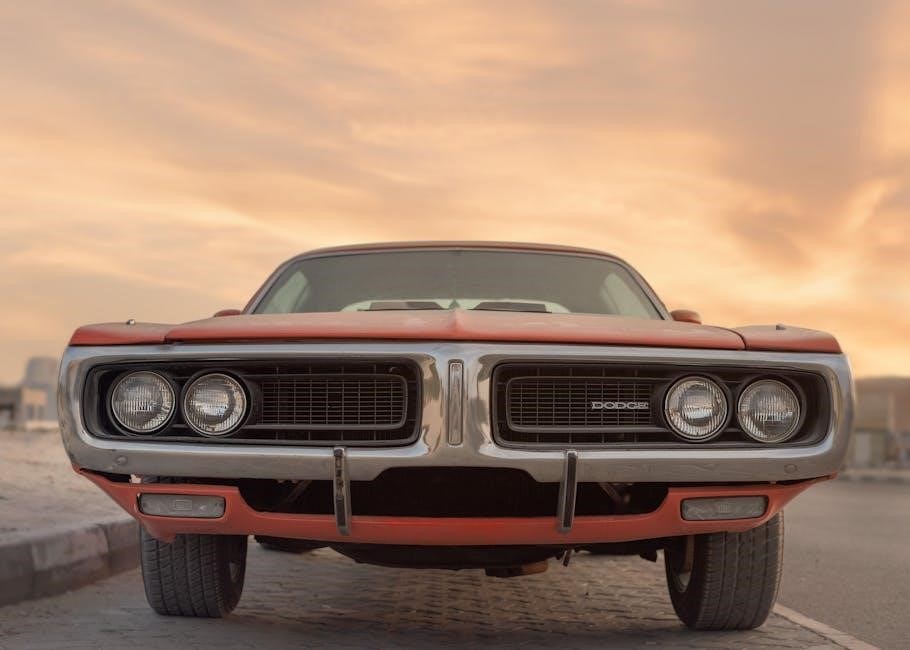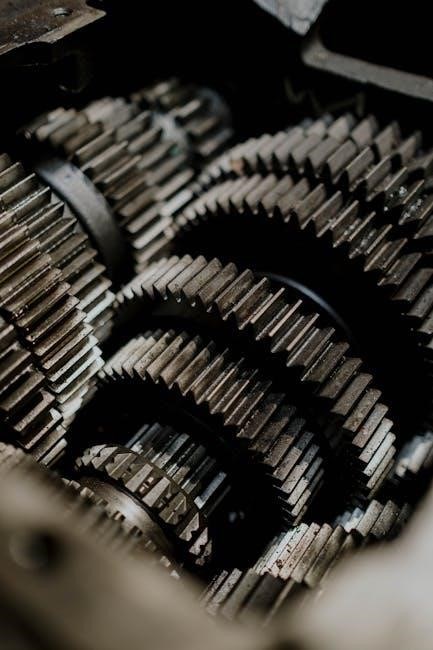dodge transmission interchange guide
Understanding Dodge transmission interchange is crucial for enthusiasts and mechanics, ensuring compatibility and performance when swapping or upgrading transmissions in Dodge vehicles. This guide provides key insights and solutions to common challenges, helping you navigate the complexities of transmission compatibility, VIN requirements, and troubleshooting. Whether you’re working on a classic or modern Dodge, this resource offers a comprehensive overview to help you make informed decisions for a successful transmission swap.
1.1 What is Transmission Interchange?
Transmission interchange refers to the process of swapping or replacing a vehicle’s transmission with another compatible unit, often to enhance performance, fix issues, or upgrade capabilities. It involves ensuring the new transmission aligns with the vehicle’s engine, drivetrain, and electronic systems. Compatibility is key, as mismatches can lead to operational failures. This practice is common among Dodge enthusiasts seeking to optimize their vehicles for specific needs, such as improved towing capacity or smoother shifting. Proper research and tools are essential for a successful interchange.
1.2 Importance of Understanding Dodge Transmission Compatibility
Understanding Dodge transmission compatibility is vital to ensure seamless performance and avoid costly repairs. Incompatible transmissions can lead to poor shifting, reduced power delivery, and even complete system failure. Compatibility issues often stem from mismatches in gear ratios, torque capacity, or electronic controls. For modern Dodge vehicles, the transmission’s integration with the engine control module (ECM) adds another layer of complexity. Proper compatibility ensures optimal performance, reliability, and longevity of the vehicle, making it essential for any transmission swap or upgrade project.
Understanding Dodge Transmission Types
Dodge offers a range of transmissions, including manual and automatic models, each designed for specific performance needs. Understanding these types is essential for proper interchange and functionality.
2.1 Overview of Dodge Transmission Models (Manual and Automatic)
Dodge vehicles feature a variety of transmissions, including manual and automatic models, each tailored to specific performance and drivetrain requirements. Manual options like the NV1500 and NV3500 are known for durability and precise control, often found in older models. Automatic transmissions, such as the TorqueFlite 8HP70 and 6HP26, offer smooth shifting and efficiency, commonly used in modern Dodge vehicles. Understanding these models ensures compatibility and optimal performance during transmission swaps or upgrades.
2.2 Key Differences Between Dodge Transmissions
Dodge transmissions vary significantly in design, functionality, and compatibility. Manual transmissions, like the NV1500, are known for their durability and simplicity, while automatic models, such as the TorqueFlite 8HP70, offer advanced electronic controls and smooth shifting. Key differences include gear ratios, torque capacity, and electronic features. Understanding these variations is essential for ensuring compatibility during swaps, as mismatched transmissions can lead to poor performance or operational issues. Each model is tailored to specific engine types and drivetrain configurations, making careful selection crucial for optimal results.
Key Considerations Before Transmission Interchange
Before attempting a transmission swap, ensure compatibility by verifying VIN numbers and transmission codes. Check fluid types, filter requirements, and electrical connections for proper functioning. Tools like scan tools and repair manuals are essential, while understanding wiring and sensor calibration is critical. Additionally, address legal aspects like emissions compliance and safety precautions to avoid operational issues post-swap. Proper planning prevents costly errors and ensures a smooth transition to the new transmission system.
3.1 Vehicle Compatibility and VIN Number Requirements
Ensuring vehicle compatibility is vital for a successful transmission swap. The Vehicle Identification Number (VIN) plays a crucial role in determining the correct transmission for your Dodge. Each VIN encodes specific details about the vehicle’s make, model, and year, which are essential for matching the transmission. Using the VIN, you can verify whether the transmission you’re considering is compatible with your vehicle’s engine, axle ratio, and electrical systems. Always cross-reference the VIN with the transmission’s specifications to avoid mismatches and potential mechanical issues. Proper VIN verification ensures a seamless integration and optimal performance post-swap.
3.2 Tools and Resources Needed for Transmission Swaps
A successful transmission swap requires the right tools and resources. Essential tools include a transmission jack, socket set, torque wrench, and fluid transfer equipment. Additionally, access to repair manuals specific to your Dodge model is crucial for guidance. Online forums and communities can provide valuable insights and troubleshooting tips. Diagnostic software may also be necessary to ensure compatibility and resolve any electronic issues. Having these tools and resources readily available will streamline the process and minimize potential setbacks during the swap.

Dodge Transmission Interchange Guide by Era
This guide categorizes Dodge transmissions by era, focusing on classic (pre-2000), modern (2000-2010), and late-model (2010-present) applications. Each era highlights unique transmission types, compatibility, and considerations for swaps.
4.1 Classic Dodge Transmissions (Pre-2000 Models)
Classic Dodge transmissions, such as the A500, 518, and 618, were commonly used in pre-2000 models like the Dodge Ram and Dakota. These transmissions, known for their durability, often required specific fluid types and regular maintenance to prevent issues like slipping or hesitation. Early models also featured manual transmissions like the NV3500, popular in trucks for their reliability. Common problems included worn clutches and faulty sensors, which could be resolved with cleaning or replacement. Understanding these vintage systems is key for successful swaps or restorations, ensuring compatibility with other classic Dodge components.
4.2 Modern Dodge Transmissions (2000-2010 Models)
Dodge transmissions from 2000 to 2010, such as the 45RFE, 545RFE, and 62TE, were designed for improved performance and efficiency. These models featured advanced automatic and manual options, catering to trucks like the Ram and Dakota. Key innovations included overdrive capabilities and increased torque handling. Common issues like overheating and sensor malfunctions were addressed through regular fluid changes and proper cooler maintenance. These transmissions laid the groundwork for future advancements, balancing power and reliability for both on-road and off-road applications.
4.3 Late-Model Dodge Transmissions (2010-Present)
Late-model Dodge transmissions (2010-present) include high-performance units like the 8HP70 and 8HP90, offering enhanced torque capacity and smooth shifting. These transmissions integrate advanced electronics and adaptive learning capabilities, improving fuel efficiency and responsiveness. Common in models such as the Charger and Challenger, they feature optimized gear ratios for both power and economy. Maintenance involves regular fluid checks and updates to transmission software for optimal performance, ensuring reliability and durability across various driving conditions and vehicle applications.

Popular Dodge Transmission Swap Scenarios
Popular swaps include upgrading for performance or addressing common issues like Hemi engine compatibility. Swapping between Ram and Dakota models often resolves transmission-related problems effectively.
5.1 Swapping Between Dodge Ram and Dakota Models
Swapping transmissions between Dodge Ram and Dakota models is common due to shared platforms and compatibility. The Ram’s heavy-duty transmissions often replace Dakota units for improved towing capacity; Ensure VIN matching for proper compatibility, as discrepancies can lead to electrical and mechanical issues. Tools like transmission jacks and adaptors are essential. Post-swap, recalibrate the ECM to avoid performance problems. This swap is popular for resolving common Dakota transmission failures while enhancing overall vehicle performance and reliability.
5.2 Interchanging Transmissions in Dodge Muscle Cars (Charger, Challenger)
Interchanging transmissions in Dodge Charger and Challenger models is popular for enhancing performance and drivability. Modern models often swap the 8-speed automatic for a more responsive manual or upgraded automatic. Ensure compatibility with engine and drivetrain configurations to maintain optimal performance. Wiring and sensor adjustments are critical to prevent errors. This swap is favored by enthusiasts seeking better acceleration and control, particularly in high-performance trims like the Hellcat and Scat Pack.

Common Issues and Solutions in Dodge Transmission Interchange
Common issues include compatibility problems, fluid contamination, and sensor malfunctions. Solutions involve proper transmission flushing, sensor recalibration, and ensuring all components are compatible with the vehicle’s setup.
6.1 Solving Compatibility Problems with Wiring and Sensors
Compatibility issues often arise from mismatched wiring and sensors between transmissions and vehicles. Ensure the throttle position sensor is clean and calibrated. Replace faulty sensors and check wiring connections for damage or corrosion. In some cases, reprogramming the transmission control module may be necessary. Always verify compatibility with your vehicle’s specific make and model. Proper diagnostics can help identify and resolve these issues effectively, ensuring smooth transmission operation after the swap.
6.2 Addressing Fluid and Filter Requirements for Different Transmissions
Transmission fluid and filter compatibility are critical for proper operation. Always use the recommended fluid type for your specific Dodge transmission, as incorrect fluid can damage components. Regularly replace the filter to prevent clogs and ensure smooth gear shifts. Neglecting fluid and filter maintenance can lead to premature wear or failure. Check your owner’s manual for the recommended fluid type and filter replacement schedule. Proper fluid and filter management ensures optimal transmission performance and longevity.
Legal and Safety Considerations
Ensure your transmission swap complies with emissions standards and passes smog tests. Always follow safety protocols, avoid exposure to harmful fumes, and wear protective gear during repairs.
7.1 Emissions and Smog Compliance After Transmission Swaps
After a transmission swap, ensure your vehicle meets emissions standards to pass smog tests. Drive the vehicle 1-200 miles before testing to allow the sensors to reset. Avoid prolonged engine idling and service your vehicle in a well-ventilated area to minimize emissions exposure. Always follow local regulations and consider professional tuning to ensure compliance. Proper documentation and inspections are crucial to avoid legal issues and maintain environmental standards.
7.2 Safety Precautions When Working with Transmission Systems
When working on transmission systems, prioritize safety to avoid injuries and damage. Always disconnect the battery and wear protective gear, including gloves and safety glasses. Ensure the vehicle is securely lifted or supported to prevent accidents. Avoid breathing in exhaust fumes and work in a well-ventilated area. Never idle the engine unnecessarily and follow proper procedures for handling transmission fluid and filters. Adhere to manufacturer guidelines and seek professional help if uncertain to ensure a safe and successful transmission swap.

Community and Resources
Engage with online forums and communities for Dodge transmission enthusiasts to share experiences and solutions. Utilize recommended repair manuals and guides for detailed, model-specific instructions and troubleshooting tips.
8.1 Online Forums and Communities for Dodge Transmission Enthusiasts
Joining online forums and communities is essential for Dodge transmission enthusiasts. Platforms like Dodge Forums and RAM Forum offer valuable insights and troubleshooting tips from experienced members. These communities provide detailed discussions on transmission swaps, compatibility issues, and repair advice. Many users share their personal experiences with specific models, such as the Chrysler 727 or Getrag 360, helping others avoid common pitfalls. Additionally, specialized Facebook groups and Reddit threads focus on Dodge transmission projects, offering real-world solutions and encouragement for DIY enthusiasts.
8.2 Recommended Repair Manuals and Guides
For accurate transmission repairs, consult genuine Dodge repair manuals or trusted guides like the Chrysler Service Manual and Haynes Repair Manual. These resources provide detailed instructions, diagrams, and specifications for various Dodge models. The Owner’s Manual (296 pages, Mar 4, 2020) also offers insights into vehicle features and maintenance. Additionally, online platforms like AllData and AutoZone Repair Help provide access to factory-specific repair information. Always use official or reputable sources to ensure compatibility and accuracy for your transmission projects.
